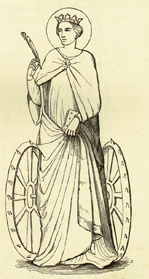Home

Home |
 |
Iconography of St. Catherine
 |
As patroness she has several attributes. She bears the palm as martyr; the sword expresses the manner of her death; the crown is hers of right, as sovereign princess; she holds the book as significant of her learning; she tramples on the pagan tyrant. All these attributes may be found in the effigies of other saints ; but the especial and peculiar attribute of St. Catherine is the wheel. When entire, it is an emblem of the torture to which she was exposed: in the later pictures it is oftener broken ; it is then an historical attribute, it represents the instrument by which she was to have been tortured, and the miracle through which she was redeemed. She leans upon it, or it lies at her feet, or an angel bears it over her head. In Raphael's St. Catherine, in our National Gallery, she leans on the wheel, and no other attribute is introduced: this, however, is very uncommon; the characteristic sword and the book are generally present, even where the crown and palm are omitted. The grim turbaned head of Maximin, placed beneath her feet, is confined, with very few exceptions, to the sculptural and Gothic effigies and the stained glass of the fourteenth century. |
Saint Catherine of Alexandria, Martyr
(c. 300 A.D.)
written by Virginia C. Raguin
|
During the persecution of a pagan emperor, often identified as Maximinus (305-313) ruler of the Eastern part of the Roman empire, citizens were ordered to sacrifice to the Roman gods. Catherine refused, rebuking the emperor for his idolatry and arguing with his counselors over points of philosophy and faith. The pagan scholars, after their debate with Catherine, were so persuaded by her arguments that they converted. Maximinus then had them executed. In most of the stories, her great beauty as well as learning become points of contention. Maximinus not only quakes before her wisdom, but is ravished by her beauty and determines that she will become his wife. Catherine clearly states that she will have no husband other than her mystical spouse, Christ. In anger over his failure to convert her by reason, or to win her to him through marriage, Maximinusís love turns to hatred, and he orders her tortured on a spiked wheel. Following standard confrontational narratives for saints lives, Catherineís righteousness is vindicated when an angel descends to destroy the wheel before it can harm her. Finally she is beheaded, and a voice from heaven speaks "Come My beloved, My spouse, Behold the door of heaven is open to thee" (Golden Legend). Her body was believed to have been transported to Mt. Sinai, site since Constantineís time of a renowned monastery dedicated to St. Catherine. |
Image: Wood engraving (19th century)
after painting by Lucas van Leyden
|